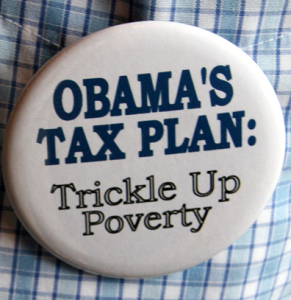
By John B. Taylor
Last year at this time a debate raged about whether economic growth and job creation has been abnormally slow compared with previous recoveries from recessions in the United States. Now that the growth rate has declined to 1.6% over the past year from 2.8%, the debate is no longer about whether. It’s about why.
The poor economic policies of the past few years is a reasonable explanation for today’s weak economy. Fiscal policy has at best provided temporary stimulus before fading away with no sustainable impact on growth. More costly and confusing regulations—including the many mandates in the Affordable Care Act and the Dodd-Frank Act—have reduced the willingness of firms to invest and hire. The Federal Reserve has employed a variety of unconventional and unpredictable monetary policies with not very successful results.
The administration and its supporters are not about to blame the slow recovery on its own policies, or those of the Fed. Instead, President Obama and his supporters have been talking about “an economy that grows from the middle out,” as he put it in Galesburg, Ill., in July. The fashionable middle-out view blames today’s troubles on policies that took root in Ronald Reagan’s administration.
The 1980s and ’90s experienced a declining trend in unemployment rates, milder and less frequent recessions, and a lower inflation rate—all of which disproportionately benefited people with middle and lower incomes, especially compared with the 1970s. These decades were also characterized by widening inequality. The reason? “Washington,” as Mr. Obama asserted in Galesburg, “doled out bigger tax cuts to the very wealthy and smaller minimum wage increases for the working poor.”
Weak economic growth today, according to the middle-out view, is the consequence of a wider distribution, or dispersion, of income (more at the upper end). This growth in inequality, the argument goes, is the consequence of tax cuts since the 1980s, a trend toward deregulation (that actually began under the Carter administration), and fewer targeted federal programs.
The key causal factor of the middle-out view is that a wider income distribution slows economic growth by lowering consumption demand. Saving rates rise and consumption falls if the share of income shifts toward the top, according to middle-out reasoning, because people with higher incomes tend to save more than those with lower incomes.
The data for the recovery since mid-2009 do not support this view. The 5.4% overall savings rate during this recovery is not high compared with the 8.4% average since 1960. It is relatively low compared to past recoveries, such as the 9.3% savings rate during a comparable period during the recovery in the early 1980s.
Moreover, data do not support the view that tax cuts in the past 30 years are responsible for the widening income distribution. According to the Congressional Budget Office, the distribution of market income before taxes widened in the 1980s and ’90s by about as much as the distribution of income after taxes.
The middle-out view fails to explain the weak economy and high unemployment today. It also fails to explain the strong economy and low unemployment in the 1980s and ’90s.
Widening income distribution can be a concern, however, especially if it signals reduced income mobility and a growing inequality of opportunity. Consider data collected by Berkeley economist Emmanuel Saez for the upper 10% and the lower 90% of the income scale. From the end of World War II until the mid-1960s, real income growth was strong for both groups and there was relatively little change in the distribution of income.
In the late 1960s and 1970s the growth of real income slowed dramatically for both groups, coinciding with the terrible economic policy of that period. Income growth sped up in the 1980s and ’90s but was faster in the upper-income group than in the lower-income group. This is the period of the widening of the distribution. According to the latest data collected by Mr. Saez, real income of both groups has recently stagnated.
What caused the differential income growth in the 1980s and 1990s? Research shows that the returns to education started increasing in the 1980s. For example, the wage premium for going to college compared to high school increased. But the supply of educated students did not respond to the increase in returns. High-school graduation rates were declining in the 1980s and ’90s and have moved very little since then. Test scores of American students fell in international rankings. With little supply response, the returns to those with the education rose more quickly, causing the income distribution to widen.
Greater economic freedom, the key policy trend of the 1980s and 1990s, did not spread to large parts of the education system. That remains true today, although increased accountability and freedom to choose schools in some states such as Florida and Texas shows what can and should be done.
The policies favored by those with a middle-out view—higher tax rates, more intrusive regulations, more targeted fiscal policies—will not revive the economy. More likely they will perpetuate the weak economy we have and cause real incomes—including for those in the middle—to continue to stagnate.
. . . . . . . . . . . .
John B. Taylor is a professor of economics at Stanford University and a senior fellow at the Hoover Institution. This article appeared in the Wall Street Journal. He blogs at EconomicsOne.com.
